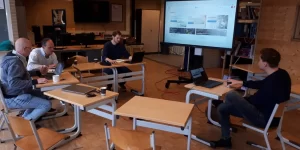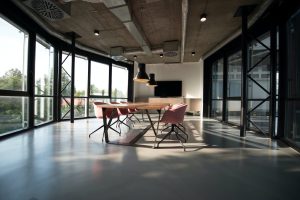Robert blogt: Making sustainability happen with data
Energy-efficient comfort, in a circular building if at all possible. That’s what I’d call the highest level of sustainability, explains Robert Dekker, Energy Consultant at Worksphere. And how will we get to this holy grail? With data, of course.
Making sustainability accessible
How comfortable is your building? You can ask your users, of course, but there’s a much more effective way: collecting data about various factors that determine whether a room is healthy and comfortable. Seeing is believing, so I’m always eager to loan out some sensors to interested building managers for a week. They’re wireless, so all you have to do is put them in the room you want to monitor carbon dioxide levels, humidity, light, sound and temperature. We then analyse that data and propose measures to improve comfort and save electricity at the same time. For me, it’s a wonderful example of how you can leverage data to enable easy sustainable development.

Smart measures thanks to monitoring
Sensor technology immediately provides a great many actionable insights, but for anyone looking to take monitoring and data analysis to the next level, there is PULSE Energy. This piece of analysis software retrieves data from building services 24/7, allowing us to detect anomalies and predict how the building services will behave in order to prevent outages, extend the lifespan of systems and improve comfort. These results are valuable enough as is, but they even help reduce energy consumption and costs as well!
For a particularly pleasing example of how PULSE Energy can drive sustainable development, just take our client Zorggroep Sint Maarten. Building data analyses showed that at one of their sites, the performance of the central heating system could be vastly improved by disconnecting the domestic hot water system. A separate gasless system was introduced to heat the tap water to the required 80 degrees, so the central heating system could produce much lower temperatures most of the year. The result? You guessed it: big energy savings.
Circular opportunities
Making a building more sustainable is not only about comfort and energy savings, but also about circularity. I admit that the reuse of materials and system for management and maintenance is really still in its infancy, but there are great opportunities out there. Together with customers with circular ambitions, we are already exploring smart ways to reuse systems and materials in their properties. When we made the Groningen Provincial Headquarters gasless, we were able to reuse the boiler, which was still functioning perfectly, with another customer. As far as I’m concerned, this approach will become increasingly common when replacing and installing building systems.

Marketplace for materials
The use of data can also give circularity a big boost, which is why we be putting together digital twins for more and more buildings, incorporating data on all materials used. By linking that information to a digital marketplace for materials, we can see which reusable materials are made available when another building is renovated or dismantled, making it possible to sustainably swap parts and materials between our many customers. This is just one of the ways in which data will help us improve comfort, save more energy and approach circularity.
Share Message
See also

PULSE Core gives Nimeto students insight into sensor technology
PULSE Core is part of the teaching material of MBO vocational school Nimeto in Utrecht. There are 10 sensors in various rooms in the school

Healthy Work Environment? Achieve this goal together with PULSE Core!
In the modern business world, creating a healthy work environment plays an important role in promoting both employee productivity and overall well-being. Facility managers and
